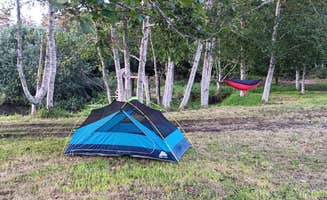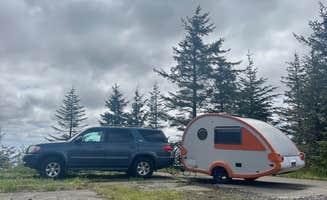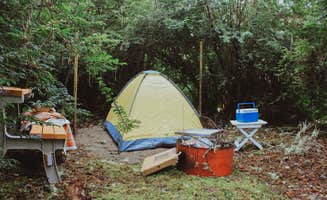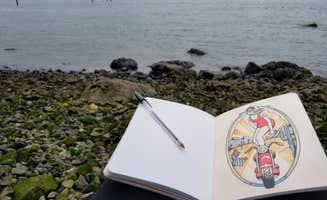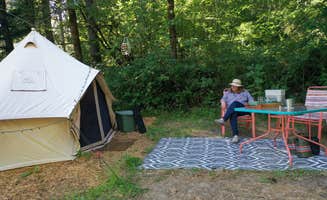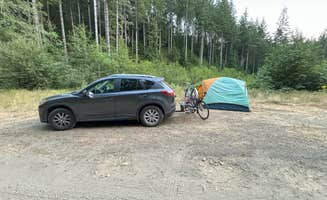Tent camping near Raymond, Washington gives campers access to multiple forest environments in the Willapa Hills region. The elevation ranges from near sea level to approximately 1,500 feet at higher forest sites, creating varied camping experiences within short distances. Winter brings significant rainfall with annual precipitation exceeding 70 inches, while summer months typically offer drier conditions with temperatures averaging 65-75°F during camping season.
What to do
Fishing opportunities: Western Lake Campground provides direct lake access for anglers. As one visitor noted, "When I was there, there were a couple of beaver working at the head of the lake," adding wildlife viewing to the fishing experience.
Bird watching: At Road to Snag Lake, the higher elevation creates excellent bird watching conditions. A camper reported seeing "tons of rabbits and wildflowers" in addition to various bird species during their stay.
Hiking forest trails: The surrounding state forest lands contain numerous unmarked trails. According to a camper at Gnat Creek Campground, "The trails are nice going along gnat Creek and you can visit the fish hatchery at the end of the trail," suggesting similar opportunities exist in the Raymond area forest lands.
Photography: The elevation changes create excellent opportunities for landscape photography. One visitor to the area mentioned, "If you go farther up the road there is a viewpoint that lets you see clear to the coast on a sunny day," highlighting the photographic potential from higher camping areas.
What campers like
Midweek solitude: The area receives minimal traffic outside weekends. A camper at Rose Creek Retreat valued "the solitude and the silence other than the leaves rustling in the light breeze," which mirrors the experience in Raymond's forest camping areas.
Concrete pads: Several sites at Road to Snag Lake feature helpful level surfaces. A camper stated, "Cement pad makes a flat tent site," which provides more comfortable tent setup options, especially in wet conditions.
Wildlife encounters: The forested environment supports diverse wildlife viewing. One camper observed, "There are several spots off the road around these radio tower stations and it is quite secluded. We didn't see any other person the whole time we were there."
Cell service: Despite the remote feeling, many camping areas maintain usable phone service. A visitor noted, "At least I have great T-Mobile signal," which can be important for safety or staying connected while camping.
What you should know
Road conditions vary: Access requires preparation for various road types. A visitor to Rock Candy Mountain Trailhead warned, "The road is dirt but some parts are very rocky. Not many dispersed camping spots just pullover spots really," which applies to many forest roads in the Raymond area.
Discovery Pass requirement: A Washington Discover Pass is mandatory for camping on state lands. One camper confirmed, "There is a sign at the entrance for needing a discovery pass to use the site. Visit their website for payment options. You have to print the pass or write the transaction number on a paper and on your windshield."
Limited amenities: Most dispersed camping areas have no facilities. A camper reported, "No amenities, obviously, but there is a concrete pad from an old structure you can park on. Other sites have solid pack gravel covered by grass."
Weather considerations: Coastal influence creates variable conditions. According to one camper, "Very peaceful and quiet. We tent camped at the very end of the road at the top. Unfortunately we could see nothing but clouds this visit," highlighting how coastal fog can affect visibility.
Tips for camping with families
Site selection strategy: Choose camping areas based on vehicle type and equipment. One visitor to Sherman Valley State Forest shared, "The campground is located in Capital Forest which is home to lots of hiking, mountain bike, equestrian, and ATV trails," suggesting families should select sites compatible with planned activities.
Safety precautions: Higher elevations require attention to edge areas. A camper warned, "There is a long drop if you lose control and fail off road. I feel if you did and survived the fall it would be expensive to recover your vehicle," emphasizing the need for careful site selection with children.
Educational opportunities: The forest environment offers natural learning experiences. One camper mentioned, "I grew up camping here, as a Boy Scout this was a perfect location for many activities," highlighting the area's value for teaching outdoor skills.
Weather preparation: Coastal proximity means changeable conditions. "It gets pretty steep going up the road. The right steep," noted one visitor, suggesting families should prepare for temperature differences between lower and higher elevation camping sites.
Tips from RVers
Small RV advantages: Compact camping vehicles work best on forest roads. At Western Horizon Ocean Shores, a camper observed, "Each site is screened by pine trees, giving you privacy in your own site," which reflects the forest environment that limits larger RV access around Raymond.
Site arrival timing: Earlier arrival improves camping options. The same visitor noted, "Not all the sites had picnic tables and fire pits, so make sure you get there early to snag the best site," advice that applies throughout the Raymond area camping locations.
Road width limitations: Forest roads often restrict larger vehicles. One camper stated, "They wrote it on barely white enough for two vehicles to safely pass each other. Not suitable for anything wider than a class B," cautioning those with wider recreational vehicles.
Leveling challenges: Prepare for uneven terrain at most sites. "Site is up a decently maintained but long and steep gravel road, doable in a Prius but she was panting by the end," reported one camper, indicating RVs will face similar or greater challenges.


